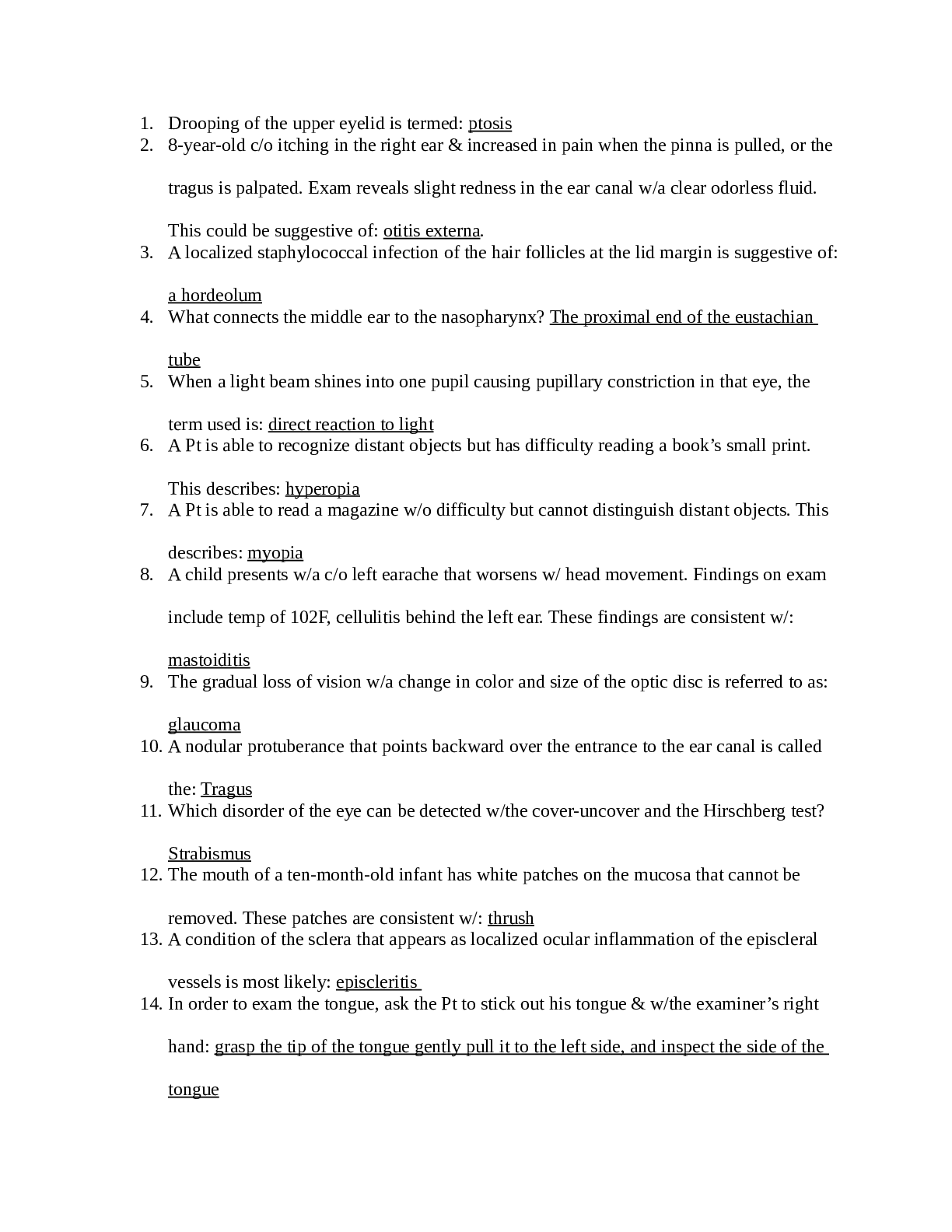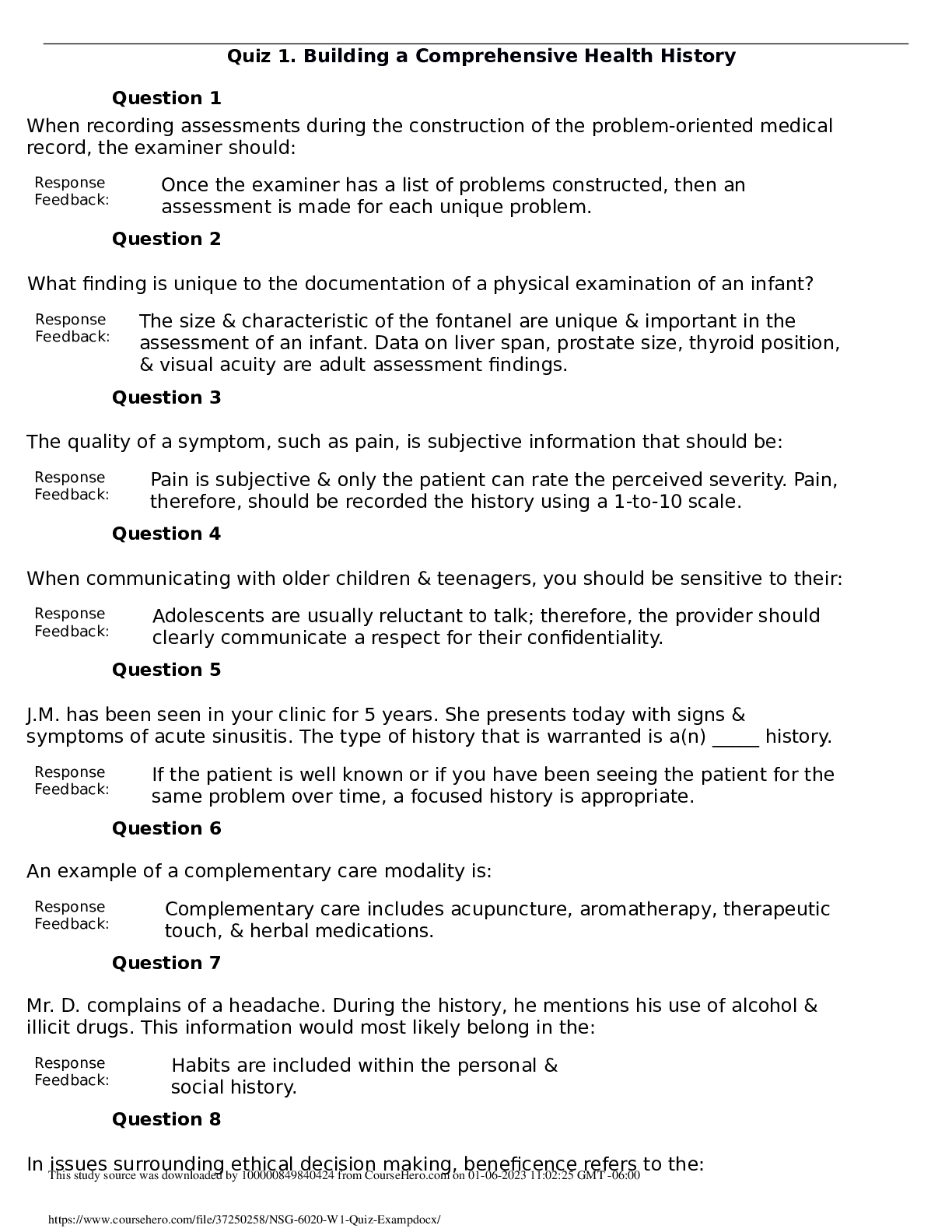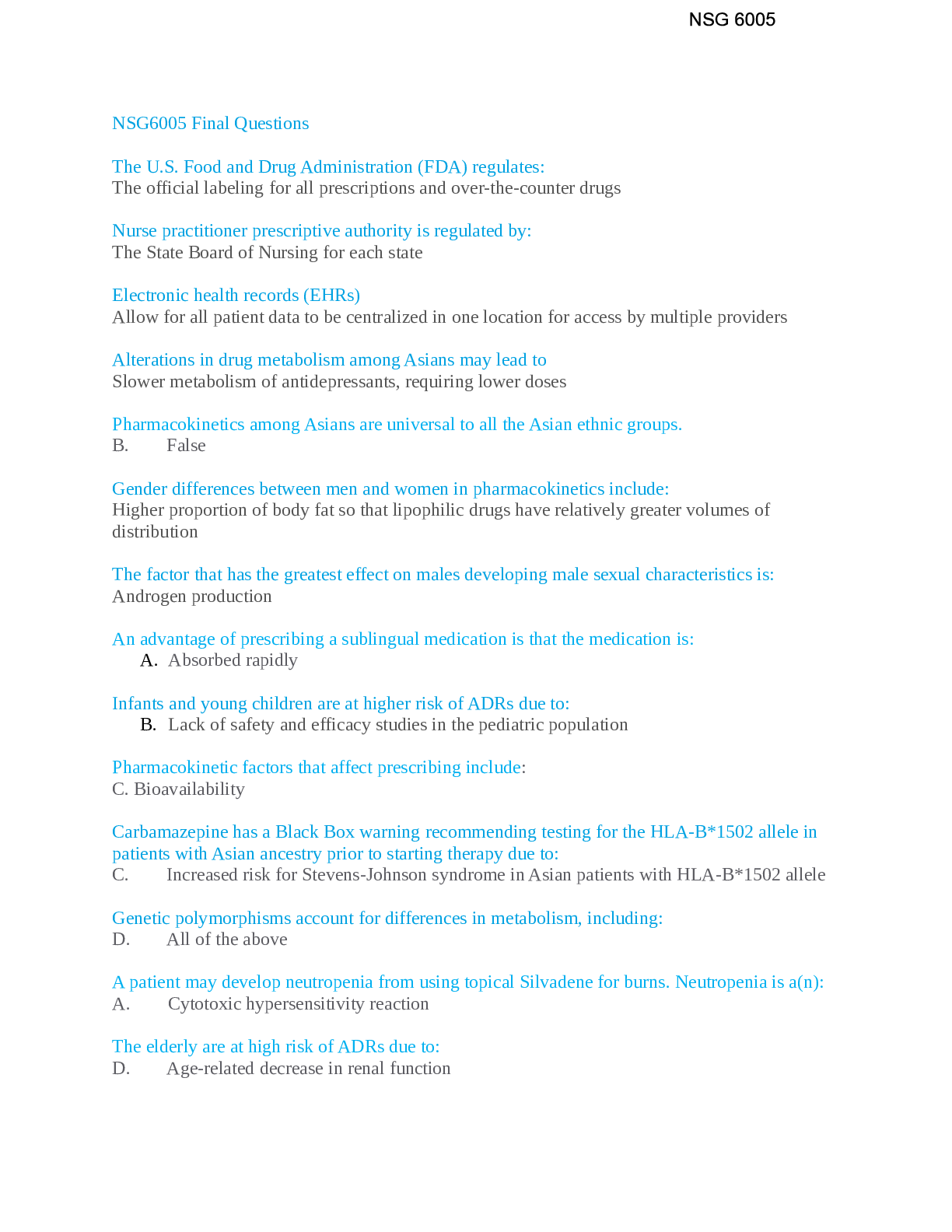Aviation Maintenance Technician > EXAM > Oral Air Exam With Complete Questions and Answers (All)
Oral Air Exam With Complete Questions and Answers
Document Content and Description Below
Oral Air Exam With Complete Questions and AnsweOral exam Air Methods complete with Questions and Answers 135.609 Day non-MTN local 800-2 135.609 Day non-MTN XC 800-3 135.609 Day MTN local 80... 0-3 135.609 Day MTN XC 1000-3 135.609 NVG non-MTN local 800-3 135.609 NGV non MTN XC 1000-3 135.609 NVG MTN local 1000-3 135.609 NGV MTN XC 1000-5 135.609 Unaided non MTN local 1000-3 135.609 Unaided non MTN XC 1000-5 135.609 Unaided MTN local 1500-3 135.609 Unaided MTN XC 1500-5 The requirement to be able to use the "local" flying area minimums The pilot must demonstrate a level of familiarity with the local flying area by passing the examination given by the certificate holder within the 12 calendar months prior to using the local flying area 135.609c and A021 Where are the local flying areas described? A021 When must the "cross country" non-local wx minimums be utilized? Any flight outside the local flying area is a cross-country operation. Pilots that have not passed a local flying area knowledge test within the previous 12 calendar months must use cross country mins 135.609c A021 You receive a flight request to fly to a hospital 100 miles from your base to pick up a patient. What information must you obtain prior to departing on this flight? Each pilot in command shall before beginning a flight become familiar with all available information concerning that flight. This information must include for a flight under IFR or a flight not in the vicinity of a airport weather reports and forecast fuel requirements alternates available if the planned flight cannot be completed and any new traffic delays of which the pilot in command has been advised by ATC. 91.103 What type of weather can you expect from moist unstable air and very warm surface temperatures? Strong updrafts in cumulonimbus clouds. What are the AMC minimum altitude for en route operations? Air Methods helicopter pilot shall when able cruise at a minimum of 1000 feet AGL day or night GOM 3.9 What are the AMC SVFR minimums for day and night? 700/2 and 800/3 GOM 3.13 When encountering deteriorating weather en route what options are available per the AMC GOM? -Divert to an alternate airport -Return to the departure point land and notify dispatch your hospital personnel of the situation to make arrangements for the care of the patient -If weather conditions and regulations permit continue to fly under IFR -Execute the double IMC procedure in section 2 of this manual it's preceding options are not available GOM 2.16 What are the steps used to maintain aircraft control during an I-IMC recovery? •Attitude •Heading (turn only to avoid known obstacles) •Power (adjust to climb power) •Airspeed (adjust to climb airspeed) When requesting assistance from ATC during an I-IMC encounter, what are the two requests that should be made, and in what order? •Radar vectors to VMC conditions •Vectors to the closest approach GOM 2.37 FAR 135.207 is titled "VFR: Helicopter Surface Reference Requirements". What does this regulation relate to? It establishes the requirement for helicopter visual surface reference for VFR flight 135.207 What is required by 135.207 in order to operate a helicopter under VFR at night? Visual surface light reference that is sufficient to see in order to safely control the helicopter 135.207 When does encountering any potentially hazardous meteorological condition in-flight require any specific action on the part of the PIC? Whenever a pilot encounters a potentially hazardous meteorological condition in-flight the pilot shall notify an appropriate ground radio station as soon as practical 135.67 When shall the sterile cockpit be in effect? Critical phases of flight: take off landing and all other operations below 10,000 feet except cruise fight. Pilots must engage the medical personnel in a continuous, diplomatic, educational effort to make them aware of the need to limit conversations on the ICS during critical phases of flight to topics related to the conduct of the flight. May you turn off aircraft external lights during HNVGO operations? You may turn off the anti-collision and strobe lights if it presents a hazard. Position lights may not be turned off. GOM 3.2 and part 91.209 Must you utilize an aircraft landing light searchlight or night sun for takeoffs and landings under HNVGO? Yes, unless environmental effects dictate otherwise for example blowing snow or something that does create a hazard GOM 3.2 part 91.205 requires a landing light for operations for hire. How low may you operate when conducting HNVGO? During the in-route phases of HNVGO, no pilot will operate below 500 feet AGL prior to initiating an Approach aided or unaided. high reconnaissance shall be conducted at or above 500 feet AGL. For HNVGO only take-off landings are authorized below 300 feet AGL GOM 3.2.2 What might cause you to experience this orientation while utilizing NVGs? Bank angles in excess of 30° in proper scanning Flickr vertigo If I pilot declares an emergency who shall they forward the report to? D.O. and or chief pilot who in turn will forward that report to the FAA within 10 days of the incident Pre-fight planning requires a pilot to determine the highest obstruction or Terrain feature and plan to clear it vertically by how much? Is there a lateral component to this planning? 300' day/ 500' night; AMC pilots may choose to circumnavigate an obstruction by a safe distance instead of flying over it. 135.615, GOM 3.14 When conducting the pre-fly NVG checks what guidance must be used? ITT 4949 operations manual or M949 operations manual ops spec A050 What are the requirements for operating in close proximity to other aircraft Briefing, and communicating with each other only requires persons on board no collision hazard approval from CP or DO During hot refueling, a pilot trained for this procedure may go how far from the aircraft for the purpose of retrieving the fuel nozzle? 30' past the rotor arc What are the top spec that specifies weather minimums for HNVGO operations? A050 is controlling the NGV operations and is the same as 135.609 When shall the W&B information be entered on the DFL and load manifest? Prior to takeoff GOM 2.63 You receive a call for a flight 1 hour before sunrise. It is mid-April and your weather checks show clear skies and light to no wind conditions. The visibility has reduced over the past two hours and the temp/dew point spread is nearing the 4-degree mark. What kind of conditions can you accept if you accept the flight? Radiation fog may begin to form especially if the winds are light Stages of thunderstorm Cumulus stage, updrafts; mature stage, updrafts, and down drafts, rain begins to fall; dissipating stage, downdrafts when the rain has ended and the down drafts have abated the T-storm has ended What causes wind Pressure differences caused by unequal heating of the earth's surface Your local news channel has interrupted to announce that a line of severe thunderstorms are moving through your area. How is this same information transmitted to aircraft in flight? Via a convective SIGMET, relayed by ATC and available on HIWAS How often is a convective SIGMET updated Every hour if the phenomenon continuing What type of cloud formation would indicate to you the possibility of mountain-wave-induced clear air turbulence? Standing lenticular are sometimes indicators of CAT. At times the air may be too dry for clouds to form yet a mountain wave (of which standing lenticular clouds are indicators) exist You are on shift and during a wx check for a pending flight request you notice that the latest METAR shows that the wind has shifted from 230 to 350 the temperature and dew point have dropped, and the pressure has begun to rise. What has happened? A cold front has passed the area What items must pilots announce on 123.025 Approach at 5 miles from landing, at one mile from landing, and upon landing. Departure: upon lift off at one mile from departure at five miles from departure Your DME shows 1 mile. Where are you in relation to the DME station? What is your attitude? Directly above the station at 6,000'AGL A turn on course will not be made until the aircraft has climbed at least. 300' AGL day and 500' AGL night Obstructions should be cleared by a minimum of? 30' during approach and departure and 15' while on the ground GOM 3.6 What is the maximum rate of descent below 300' AGL during an approach other than a normal approach to a clear area? "Below" 200 FPM that means at 300' AGL the time to touch down should be at least 90 seconds GOM 3.6 What hazardous conditions might you expect if Virga is spotted in the vicinity of your flight route? Strong down drafts associated with a Microburst What are the two greatest hazards to avoid if presented by a thunderstorm? Turbulence and hail Fly into presidential TFR and being intercepted. What frequency and transponder code are you going to use? 121.5 and 7700 If the pilot tube becomes clogged which instrument becomes unreliable? The airspeed indicator What common NVG malfunctions might be acceptable depending on the severity of the problem? Fixed pattern noise/honeycomb, distortion, veiling glare, dark/black spots, bright spots, emission points (stars), output brightness variation, image disparity What common NVG malfunction would render them unsuitable for operations? Shading, edge glow, flashing/flickering intermittent operations What are some self-imposed stresses that might impact your ability to safely conduct operations including night and NVG operations? Drugs, Exhaustion, Alcohol, Tobacco, Hypoglycemia What are the 135 currency requirements for Aircraft Day, Night, NVG, and IFR? -Day-3 takes off and lands within the preceding 90 days. -Night-3 takes off and lands at a full stop from the period between one hour after sunset to one hour before sunrise -NVG's-if within the look-back period you have completed 6 HNVGOs (look back period is two calendar months prior to the month the HNVGO is to commence *To get current- you must have completed 6 HNVGO within the look back period of 4 months from the month prior to when the HNVGO is to commence -IFR-6 instrument approaches, Holding procedures and task, Intercepting and tracking courses through the use of navigational equipment What are your approved weather sources? The National Weather Service A010 Could also use approved sources: Telvent, Duats, Foreflight How do we determine if the area we are operating in is Mountainous or Non-mountainous? AIM Figure 5-6-5 and Part 95 What are the NGV currency requirements for crew members? NGV flight training is required for medical crew members who have exceeded 6 months of HNVGO. Training will consist of three HNVGO without a patient on board and the PIC is to be current in HNVGO rs [Show More]
Last updated: 1 year ago
Preview 1 out of 5 pages

Buy this document to get the full access instantly
Instant Download Access after purchase
Buy NowInstant download
We Accept:

Reviews( 0 )
$10.50
Can't find what you want? Try our AI powered Search
Document information
Connected school, study & course
About the document
Uploaded On
Sep 11, 2023
Number of pages
5
Written in
Additional information
This document has been written for:
Uploaded
Sep 11, 2023
Downloads
0
Views
67






.png)

















